Test report film scanner Reflecta x²-Scan: Detailed review
At the time of Photokina 2008, Reflecta brought the x²-Scan as the subsequent model of the Reflecta XScan to the market. As its forerunner, the x²-Scan works differently to other filmscanners with a CMOS-Chip as image sensor. Normally, a CCD-sensor is applied. This means that a small format slide or negative is not scanned line by line by a CCD-line sensor but captured at once. A x²-Scan is basically a kind of static digital camera that simply photographs off the film that is put in.
This scanner was removed from the market in December 2009. There is no successor for it.
In the following test report we want to show how the scan quality has improved in comparison with the old xScan and if the device can compete with the scanners of common function.
Equipment, accessoires and performance data of the film scanner
The equipment of the Reflecta x²-Scan is small but complete. Thus, with the scanner, one gets a film holder for a film strip of small format images with up to 6 images and a filmholder for up to 3 framed slides. The attached CD contains exactly the same software as the former model xScan: the twain-driver software, the programe for the image processing and image viewing ArcSoft PhotoImpression 6, the Adobe® Acrobat Reader as also the handling instructions. This instruction manual is also sent in form of a small book in the languages German, English, French, Italian, Spanish and Dutch. The USB-connecting cable is firmly fixed to the device. There is no need to have an electricity cable and/or power supply, as the scanner is provided with electricity through the USB connection.
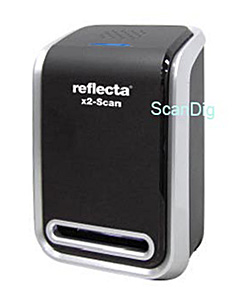
An unusual accessoire for a scanner is the brush that is included in the scope of delivery for cleaning the glass plate in front of the sensor in the interior of the device. It consists on a plastic holder with a material similar to microfibre at the end that is very soft and therewith very gentle to glass and absorbs dust lints or similar things.
During the use of the scanner, the brush results to be a very practical and, in the particular case of this device, also necessary accessoire. Due to its position, the sensor that is right under the orifice for the film holders, is hardly protected against the dust, so that the brush is oftenly needed to clean the sensor. This works perfectly with the brush and without damaging the glass.
According to the description of the producer, the scanning velocity is, as it was already the case in the xScan, not more than a second for each image. Therewith, this mini-scanner is more than 100 times faster than some professional filmscanners. Also the technical data did not change(colour depth 24 bit, resolution 5 megapixel, USB 2.0 connection) and clearly talk the talk of a digital camera. With the x²-Scan, Reflecta brought a complete solution for the digitalization of film material with the support of the digital camera - technique into the market.
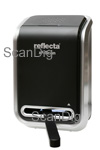
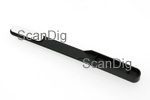
The price is the same as the xScan and therewith sensationally cheap for such a fast filmscanner. But also in case of the x²-Scan there is to apply: according to the technical data of the producer, one cannot expect a professional image quality. By scanning a realistic image area with the maximum optical resolution of 1800 ppi, then, approximately 4 megapixel are left. By the maximum density of 3,0 Dmax, a density of approximately 2,5 can be concluded; this is much too less for getting all the details in the shades and lights. And an automatical dust and scratches corrector as ICE or iSRD is technically of course also not possible. Thus, already due to the nominal data of the producer, one should not expect too much from the image quality of this device.
As it is the case of its antecessor, the Reflecta x²-Scan is not a scanner for the professional archive of slides or negatives but rather a device to get the images into the PC in a fast and easy way and for example, to view them on the PC screen or to public them on the internet. Thus, Reflecta did also not make a professional device from the x²-Scan, a thing that was also not to expect.
Installation and initial operation
The installation of the Reflecta x²-Scan is done in the same way as most of the other USB devices. First, the twain-driver is installed by simply putting the attached CD in the drive and choosing the driver installation. After that, one installs the ArcSoft PhotoImpression 6 that is also included in the scope of delivery by a simple click.
Before one connects the scanner by USB 2.0 to the PC, the CD has to be taken out of the drive - otherwise, the initiation of the scanner does not work and by trying to scan one gets an error message. Once the CD is removed from the drive and the scanner is connected, a window appears with the message that the new hardware has been found. Here, one clicks on "Install the driver automatically" - and exactly this will happen.
The x²-Scan has no switch on - off button: as soon as it is connected with the PC, the power lamp shines in a noble blue colour and it is ready for operation. Now, the scanning can start. During the first start of the scan-software the scanner is calibrated and this is the reason why one has to care that there is no film in the scanner yet. But this is clearly advised right before the start of the calibration.
Scanning framed slides
The film holder for the framed slides can capture up to three slides at once. These are put true-sided into the opened holder that is closed afterwards. Compared to the film holders of the old models of the xScan, the new ones have a much higher-valued appearance. They certainly do not achieve the quality of the film holder of Nikon, but one also does not have the feeling to hold some cheap plastic in one's hands.
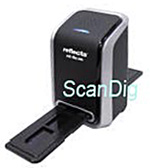
The charged holder is now pushed into the scanner from the front side. Thereby there is to care that the film holder can be only pushed from one side into the scanner. The right direction of adjusment is marked either at the film holder as also at the scanner by some arrows. The holder catches at the right positions so that the film material is in the right position to be scanned. Contrary to the case of the former xScan, the film holder can be now moved in both directions. Thus, in case the holder has been moved too far, it is not necessary to push it through and reinsert it but simply pull it a piece backwards.
But there is an important restriction in the case of the slide holder: the frames of a thickness exceeding 2 mm cannot be inserted as then the holder cannot be closed anymore. There, reflecta might not have thought outside the box, as the in-house CS frames can be easily used due to their low thickness. This circumstance should not be missed to be considered during the purchase of a x²-Scan.
The scan-software did not change at all. It can be only started over the twain-interface of a respective programe. Beside the attached Arcsoft PhotoImpression, another programe for the image processing as for example Adobe® Photoshop® Elements, is also appliable. But it is only possible to scan in a more or less comfortable way with the attached PhotoImpression: only with this programe it can be determined if the inserted film is a slide, a colour negative or a film in black and white, as also the desired resolution and colour depth can be adjusted. During the twain-import over Photoshop®, one obtains a picture that is simply the film that had been photographed off. In case it is a negative, we will also have a negative image on screen.

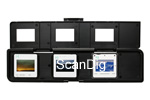
Of course, all the adjustments that can be done with PhotoImpression previously to the scan can be also done with Photoshop® after the scan - this procedure is not very comfortable, but there is no difference in the quality: PhotoImpression does not do anything else than correcting the image of the film with an automatic image and, given the case, to convert it into a positive. The possible adjustments of the resolution in this case (it can be chosen between 1800 and 3600 ppi) and colour depthj (24 or 48 bit) lead, if needed, to a retroactive interpolation. As it is the case in the previous model, the hardware only works with 1800ppi and 24 Bit.
A slide scan with PhotoImpression has a very simple procedure: first, there is to click on "open the image" and choose "captured by scanner". Here, the desired image format is choosen (TIF or JPG), the destination folder, the type of film set to slide, and then the resolution and colour depth is determined. Thereby it is recommendable to leave the two last mentioned adjustments at 1800ppi and 24Bit, as otherwise the data, as already mentioned, would be only interpolated. It is not possible to determine the scan area - the complete slide is always photographed.
By clicking on "capture", only one window appears with a live-image of the inserted image. Once one is convinced that the right image is inserted, one clicks on "snapshot" or presses the newly arranged scan-button at the device that occupies almost the whole upper part of the device so that it can't be comfortably handled. The scanned image now appears at the upper edge of the window in a stylized film strip. Now, the film holder can be further pushed and a snapshot of the next slide can be made until all the slides to be scanned are done. Of course it is possible to charge the film holder in between with new slides. By clicking on transfer, the marked images are now saved in the previously choosen destination folder that opens at the same time automatically in PhotoImpression and which contence is shown in thumbnail format. There is to consider that a maximum of 12 images can be captured at once before clicking on Transfer in order to save the images.
Scanning negative slides
The film holder for negative slides can capture a film strip up to six images. Above and underneath each image there is a guiding rail that captures the perforation and therewith fixes the image into the right position.

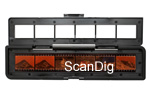
The procedure in case of the negative scan does not differ from the scanning of slides except that in case of using PhotoImpression, the film type is configured as "negative" before the scanning. Also the film strip holder is provided with some markings with which the right adjustment for the introduction into the scanner is recognizable and it catches in the right positions for scanning.
The film strips longer than 6 images or complete film reels cannot be scanned with the film holders included in the scope of delivery as they are not designed in a way that at their ends, some film material could stick out. It is also not possible to insert some APS films into the film strip holder.
The inserting of the film strips into the film holder is relatively easy if the film strips are even. But if these are curved, the inserting will take a lot of time, as the film strips repeatedely slip during the closing of the film strip adapter. During the insertion of the negative strips, one should not miss to use some cotton gloves as otherwise one soon touches the film surface and leaves some ugly fingerprints.
The software included in the scope of delivery
As described above, the software equipment of the Reflecta x²-Scan is limited, as it is also the case in the previous model, to the twain-driver software as also ArcSoft's PhotoImpression 6. It is a small but nice tool for administering, viewing and processing digital images. It is possible to issue some slide shows with or without background music, images can be turned, sorted, printed, sent as an email, renamed and converted in the batch modus, frames and cliparts can be added to the images and some simple image processings can be made.

The image processing functions provided for this are divided into several groups. Under "Adapting" one finds some tools as for example the adjustment of brightness, contrast and sharpness, colour corrections, the automatic or manual correction of red eyes and the cutting and stageless turning of images.
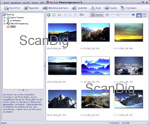
The tool group "Retouching" includes the tools healing brush, clone stamp, illuminate/darken, sharpening and soft-focus effect, and all of them can be adjusted in the size of the brush and in the intensity. Moreover, there is a paint brush, a function for drawing some lines and an eraser. Under the group "clipboard" there are some optional tools with which one can mark some parts of the image, copy them into the clipboard and reinsert them from there into any other image.
ArcSoft PhotoImpression 6 is of a simple handling and it is very funny to beef one's images up with this software. Concerning the function volume, it is of course not comparable with Adobe® Photoshop® Elements, but finally, this software only would cost almost as much as the Reflecta x²-Scan mit PhotoImpression.
Image quality
Now we come to the point of our test that might be the most interesting one for all of us: has the image quality of the previous model, that was not really convincing, improved with the x²-Scan?
Of course, one cannot expect from the x²-Scan that as a scanner that principally works as a simple digital camera, wich means that it simply photographs off the original, delivers such good results as a real scanner that scans the original line by line. Also the price is not according to such a device.
The Reflecta x²-Scan works as a webcam. One sees on the screen a live picture of the integrated camera and is able to make a fixed image of it by pressing a button. And the quality of this fixd image is unfortunately less convincing in the delivery status as it was the case in the previous model. The x²-Scan certainly provides a lot of drawing in the dark image areas, but therefore, the bright image areas get lost much too early. Those image areas that are more or less bright already do not have any drawing anymore.
But this circumstance can be handled with a little trick, so that one can obtain some scans with a balanced brightness. Therefore, the data file "OVTParam.set" must be changed in the programe file of PhotoImression (as a standard, it is the file "C:\Programs\ArcSoft\PhotoImpression 6"). Therefore, first you have to close PhotoImpression and make a safety copy of this data file so that you can restore the original at any time without a problem in case anything goes wrong. Then open the original data file "OVTParam.set" with a text editor. Then, in the paragraph [Slide] , change the value behind Para3= from 0x10:0x08 into 0x10:0x05 . Thus, you only replace the 8 at the last position of this line by a 5. Now, safe this data file(and overwrite therewith the original).
The next time you scan with the x²-Scan over PhotoImpression you will see that now the picture has a correct brightness. This trick only works in the scans done with PhotoImpression. In case of the use of other programes, this procedure does not work. Please consider that with such an action, you only adjust the brightness - the contrast (Kontrastumfang) is not changed thereby.
Unfortunately, the contrast range did not improve in comparison with the previous model and therewith, it is still very low. In the darker image areas that can be easily drawed by high quality scanners, also after applying the trick, there is no drawing visible at all any more, and also the details in the bright areas of the image get lost soon.
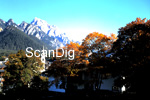
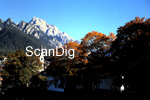

In order to get a first impression from the image quality, we have added three image examples. The first shows a scan with an x²-Scan in the factory setting. For the second image, we have ajusted the brightness through the "OVTParam.set"- data file. In the last image you can see a comparison scan of the same slide with a Nikon CoolScan 5000 ED (the top-model among the filmscanners that we also use for our scan-service) - without any kind of corrections done in the scan-software, a thing that anyway would not be possible in the case of the x²-Scan. By this way you can see how the image actually should look like. Click on the thumbnails in order to see an enlarged representation of the images.
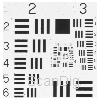
During a resolution test with the USAF-testchart, with a generous will of interpretation, it is hardly possible to distinguish the horizontal lines of the element 4.6 and the vertical lines of the element 4.4. Therefrom, a medium resolution of only about 1300ppi results. This is 72% of the nominal resolution. Thus, the resolution capacity of the x²-Scan has, compared with the previous model that achieves an effective resolution of 1500 ppi, worsen a little. In order to discard the use of a defective model we repeated the test with two further devices and got the same result. It would have been nice if the device at least had achieved the resolution of the previous model of 1500ppi. The fact that a following model is worse than the older one in this concern is really unusual and, according to my opinion, also not understandable.
Thus, by doing a scan with the Reflecta x²-Scan with the highest resolution of 1800ppi, one effectively obtains an image with the resolution of only 1300ppi. Concerning the small image format (36x24 mm), this means that such a scan only contains 2,3 megapixel of image information. The good filmscanners achieve 10-20 megapixel in case of small image format.
The missing of a dust and scratches corrector is system-related and has of course also a negative effect on the image quality: also in the case of carefully cleaned orginals, there are many disturbing dust particles and fuzzs visible on the image. And who wants to clean thoroughly one's films before each scan with a device with which it is supposed to be able to work in a specially fast and easy way?
Obviously, the Reflecta x²-Scan is not apt to archive one's valuable film material nor for issuing scans for high quality images. Its application area is and remains clearly the digitalization of film material for the fast transfer via email in order to, for example, to send some friends the snapshots of the latest holidays or in order to get one's film material into the computer for the image selection in order to enlarge later on the selected images or scan them properly.
Scanning speed
The scan speed should be, according to the system, unequally higher than in the case of conventional scanners. And the issue of a snapshot really takes, as indicated by Reflecta, only about one second. But the issue of a finished image file that takes place after clicking on "transfer" in the scanning window, takes, depending on the capacity of the performance of the computer as also the adjusted resolution and colour depth, a further half a minute. A normal scanner with this resolution also achieves this. Thus, in this case there is also no improvement in comparison to the previous model - the processing times remained exactly the same.
| Scanning individual images |
Duration |
| Snapshot |
0:01 min |
| Transfer 1800ppi 24Bit |
0:21 min |
| Transfer 1800ppi 48Bit |
0:26 min |
| Transfer 3600ppi 24Bit |
0:24 min |
| Transfer 3600ppi 48Bit |
0:39 min |
There is no difference in the scan speed during the processing of slides and negatives.
We obtained the scanning times listed above with a computer of 3 GHz pentium processor and 2 GB main storage. The scanner was connected through a USB connection. The transmission times increase significantly if instead of a USB 2.0 one uses a much slowlier USB 1.x connection.
Summary, conclusion
There is only a slight difference between the x²-Scan of Reflecta and its previous model x-Scan. Only the design of the device and the film holder have changed a little. The image quality leaves a lot to be desired. The contrast range is simply much too low and the achievable effective resolution of 1000 dpi barely produces image files with approximately 2 megapixels; today, the most simply digital cameras of mobile phones achieve these values.
The X2-Scan is a very cheap device for the fast and easy digitalization of film material for simple applications. Those who want to quickly scan some slides or negatives in order to send them to some friends or to include them in a web album will cope very well with this device. But this device is not apt for the unique and permanent archiving of one's photo stock. If one scans one's complete photo collection with the x2-Scan, one should not destroy the originals, as one day, one might want to scan them properly.
Film scanner purchase
Visit our Filmscanner-Shop, the only shop on the internet that is specialised on film scanner and accessoires. We can provide you every filmscanner to a very attractive price and can also provide you with accessoires as film holders and optional adapters during the after buy period.
Back to the film scanner tests index
|